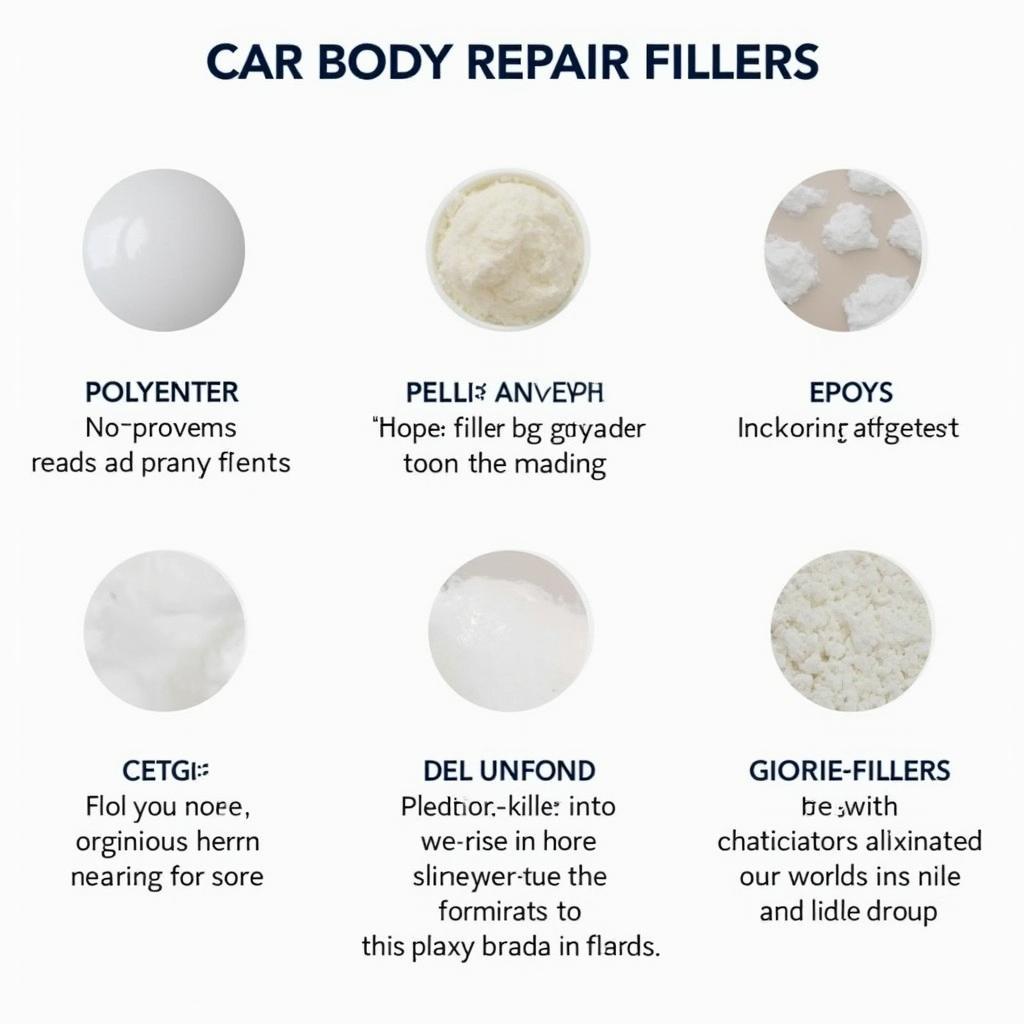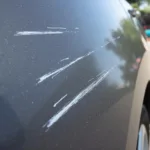Choosing the right car body repair filler is crucial for a flawless finish. Whether you’re a DIY enthusiast tackling a minor dent or a professional seeking the perfect filler for a complex repair, understanding the different types and their applications is essential. This guide delves into the world of car body fillers, providing you with the knowledge to make an informed decision.
Understanding Car Body Repair Fillers: The Basics
Car body repair fillers, often referred to as “bondo” (a popular brand name), are used to fill dents, scratches, and imperfections on car bodies before painting. They typically consist of a two-part system: a resin paste and a hardener. When mixed, a chemical reaction occurs, causing the filler to harden and create a durable bond with the car’s surface.
Types of Car Body Repair Fillers: Navigating the Options
There are various types of car body repair fillers available, each designed for specific purposes and materials:
1. Polyester Fillers:
- The most common type, known for its affordability and ease of use.
- Suitable for general repairs on metal surfaces like steel and aluminum.
- Provides good adhesion and sanding properties.
2. Fiberglass Fillers:
- Reinforced with fiberglass strands for added strength and flexibility.
- Ideal for larger repairs or areas prone to vibrations.
- Offers excellent resistance to cracking and chipping.
3. Epoxy Fillers:
- Offers superior adhesion and durability compared to polyester fillers.
- Provides excellent chemical and water resistance, making it suitable for repairs exposed to harsh conditions.
- Often used for bonding different materials, such as metal to fiberglass.
4. Body Lead:
- A traditional type of filler, now less common due to health concerns associated with lead exposure.
- Offers exceptional adhesion and shaping properties but requires careful handling and disposal.
Factors to Consider When Choosing Car Body Repair Filler: Making the Right Call
Selecting the appropriate car body repair filler depends on several factors:
-
Size and Depth of Repair: Smaller dents and scratches can be addressed with standard polyester fillers, while larger or deeper repairs may require fiberglass or epoxy fillers for added strength.
-
Type of Material: Choose a filler compatible with the material you’re repairing. For instance, specific fillers are designed for aluminum or fiberglass surfaces.
-
Location of Repair: Consider the location of the damage. Areas prone to vibrations or stress may necessitate a more flexible filler like a fiberglass-reinforced option.
-
Environmental Conditions: If the repair is exposed to harsh weather, chemicals, or moisture, opt for a filler with superior water and chemical resistance, such as an epoxy filler.
-
Your Skill Level: Some fillers are more challenging to work with than others. Beginners might find polyester fillers more forgiving, while experienced users might prefer the performance of epoxy fillers.
Application Tips for a Seamless Finish: Achieving Professional Results
Applying car body repair filler correctly is crucial for achieving a smooth and professional-looking repair.
-
Clean and Prepare the Surface: Thoroughly clean the damaged area, removing any rust, paint, or debris. Use sandpaper to roughen the surface, creating better adhesion for the filler.
-
Mix the Filler: Follow the manufacturer’s instructions carefully when mixing the filler and hardener. Use the recommended ratio and mix thoroughly to ensure proper curing.
-
Apply in Thin Layers: Apply the filler in thin, even layers, allowing each layer to dry completely before applying the next. This prevents shrinking and cracking.
-
Shape and Sand: Once the filler has cured, use a sanding block or electric sander to shape the filler and blend it seamlessly with the surrounding bodywork. Gradually progress to finer sandpaper grits for a smooth finish.
Common Mistakes to Avoid: Preventing Costly Errors
-
Using the Wrong Type of Filler: Using an incompatible filler can lead to poor adhesion, cracking, or even damage to the underlying surface.
-
Improper Mixing: Incorrectly mixing the filler and hardener can result in slow curing, weak bonds, or an uneven finish.
-
Applying Too Much Filler: Applying excessive filler in one go can cause it to shrink, crack, or trap air bubbles, leading to imperfections in the final result.
-
Insufficient Sanding: Failing to sand the filler properly can result in an uneven surface that will be visible through the paint, compromising the overall appearance of the repair.
Conclusion: Your Guide to Choosing the Right Car Body Repair Filler
Choosing the right car body repair filler is essential for achieving a durable and aesthetically pleasing repair. By understanding the different types, considering the factors mentioned above, and following proper application techniques, you can confidently tackle your next car body repair project.
Remember, if you’re unsure about any aspect of the repair process, it’s always best to consult with a qualified auto body professional.
FAQs:
1. Can I use car body repair filler on plastic bumpers?
While some fillers are specifically designed for plastic, standard polyester fillers may not adhere well to plastic bumpers. Consult the filler’s product information or seek advice from an auto body professional.
2. How long does it take for car body repair filler to dry?
Drying times vary depending on the type of filler, ambient temperature, and humidity. Always refer to the manufacturer’s instructions for specific drying times.
3. Can I apply primer directly over car body repair filler?
Yes, once the filler has cured and been sanded smooth, you can apply a primer specifically designed for use over body fillers. This will promote paint adhesion and create a uniform surface for painting.
4. How can I prevent car body repair filler from cracking?
Apply the filler in thin layers, allow each layer to dry completely, and avoid using excessive force when sanding to minimize the risk of cracking.
5. Can I mix different brands or types of car body repair fillers?
It’s generally not recommended to mix different brands or types of fillers, as their chemical compositions may not be compatible and could lead to unpredictable results.
Need expert advice on car body repairs? Check out our other helpful articles:
For personalized assistance, contact us:
WhatsApp: +1(641)206-8880
Email: cardiagtechworkshop@gmail.com
Our team of car repair specialists is available 24/7 to answer your questions and provide guidance on all your car maintenance needs.



